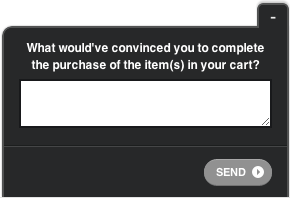Among many survey types that either offer you qualitative or quantitative insights, the Likert Scale gives you the best of both worlds.
To best describe the Likert scale in brief, it’s a 5 or 7 point scale that collects qualitative data in the form of options that say“I agree” or “I disagree” and represents these insights as easy to analyze quantitative data reports.
Here are the eye-opening points we’ll cover in this article:
Let’s start with developing a clear understanding of the Likert scale, how it’s different from other surveys and more.
Likert Scale: Definition
Likert scale is a psychometric and unidimensional scale from which respondents pick the best option representing their views on a topic. Generally, researchers use this survey scale to gauge people’s attitudes and perspectives towards different things, which cannot be polarized.
Companies use the Likert scale in their surveys to understand the target market and how satisfied customers are with them, what they think of the brand and product, and more.
It is not the best option to assess attributes such as age, gender, and demographic parameters but works excellent when gathering opinions using agree or disagree statements.
Since opinions and views are not always polar, using this scale with five to seven options ranging from ‘Strongly Agree’ to ‘Strongly disagree’ allows respondents more room to answer honestly and not feel restricted to choose any definite answer.
For example, one person may be liberal on some topics but may hold conservative thoughts on others. So, offering them statements with ‘Agree’ and ‘Disagree’ options is the right way to understand their viewpoint.
This scale was developed by psychologist Rensis Likert and had several variants like the Guttman scale, Bogardus scale, and Thurstone scale.
The Likert scale operates on the assumption that the intensity and strength of an experience are linear, meaning it can go from total agreement to total disagreement. It also assumes that attitudes are measurable.
The most popular types of Likert scale are 5-point and 7-point scales with one neutral and equal positive and negative options. Here’s an example of a 5-point scale:
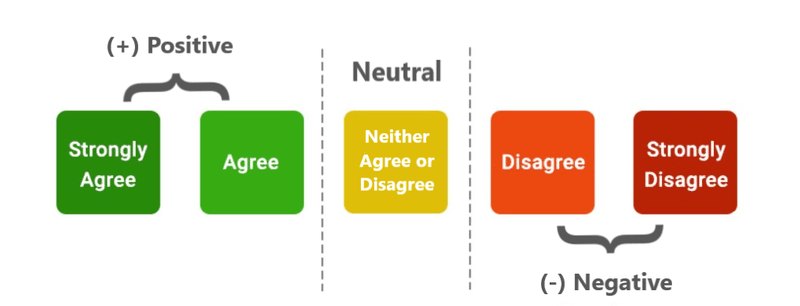
Difference Between Likert Scale and Likert Item
Likert item is the statement used in the survey that respondents evaluate using dichotomous options.
A Likert scale is the total of all the responses a survey gathers. There can be more than one Likert item in a Likert scale survey.
Here is an example:

In this survey, four statements related to a topic come one by one as the respondent answers each question. Each of these statements is a Likert item.
5‐point and 7‐point Scale: Does It Matter?
The two most widely used scales are the 5-point (also known as the unipolar Likert Scale) and the 7-point (also known as bipolar Likert scale) scales. A lot of research on the scales confirms that these two scales are the most effective in collecting plausible and accurate feedback data.
[Related read: 13 Ways to Collect Customer Feedback for Your Website]
Factually speaking, researchers have confirmed that the information from Likert items on such a scale tends to become less apt as the number of points goes beyond 7 or drops below 5.
Here are some arguments on why each one is preferred and what they bring to the table.
Why consider a 5-point scale
- These are less confusing.
- Less effort and time-consuming.
- Highly mobile-responsive as it fits the screens better.
- Some researchers reported that 5-point scales are more reliable.
- 5-point scales can be easily understood by people taking surveys.
- If you want to gauge an idea that can have responses ranging from the maximum amount of something to a minimum, then a unipolar or 5-point scale is an apt option.
- Many researchers use a 5-point scale to increase response rate and quality and reduce the respondents’ “frustration level”.
- A good option when you do not want to measure negative effectiveness through your statement.
- A good option for Likert-scale surveys with multiple Likert items.
- The quantitative data from the 5-point scale is easy to analyze as there are fewer points to consider.
- It’s a common and universally used scale, so it’s easy to compare data gathered through the 5-point scale.
But,
- The results from the 5-point scale may not be objective.
- It cannot measure all opinions.
- Respondents are more susceptible to lean towards the neutral option.
Why consider a Bipolar or 7-point scale
- A bipolar Likert scale can create better correlations with t-test results ( A type of inferential statistic that concludes whether or not there’s a notable difference between the means of two groups that may or may not be related due to specific features.)
- According to the psychometric literature, having more scale points is better in some cases as it gives respondents a lot of options to pick.
- A 7-point scale allows for a good balance between enough points of discrimination without maintaining a lot of response options.
- Gives a true evaluation of respondents’ intent and feedback.
- A suitable option for surveys dealing with usability evaluations.
But,
- The previous answers may affect the responses.
*Note:
There can be many points on such a scale from four to nine or more. It depends on the survey maker and the needs of the survey itself. However, scales with a neutral point with equal positive and negative points perform well and gather comparatively accurate data. That’s why 5-point and 7-point Likert scales are used more commonly.
Likert vs. Rating Scale
Likert scale is a type of rating scale, but not all rating scales are Likert scales. Here’s a Venn diagram to best describe the relationship.
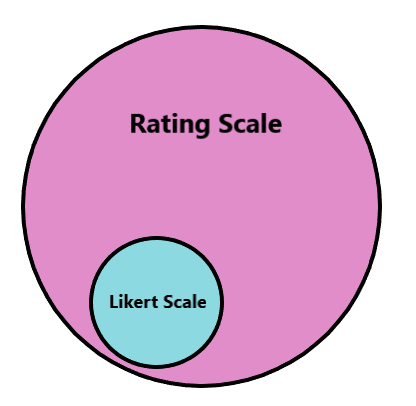
The rating scale can consist of anything from emojis, stars to numbers, depending on the nature of Likert items and the preference of the survey creator. Here’s a more relatable example of how the Likert scale looks different from the Rating scale.
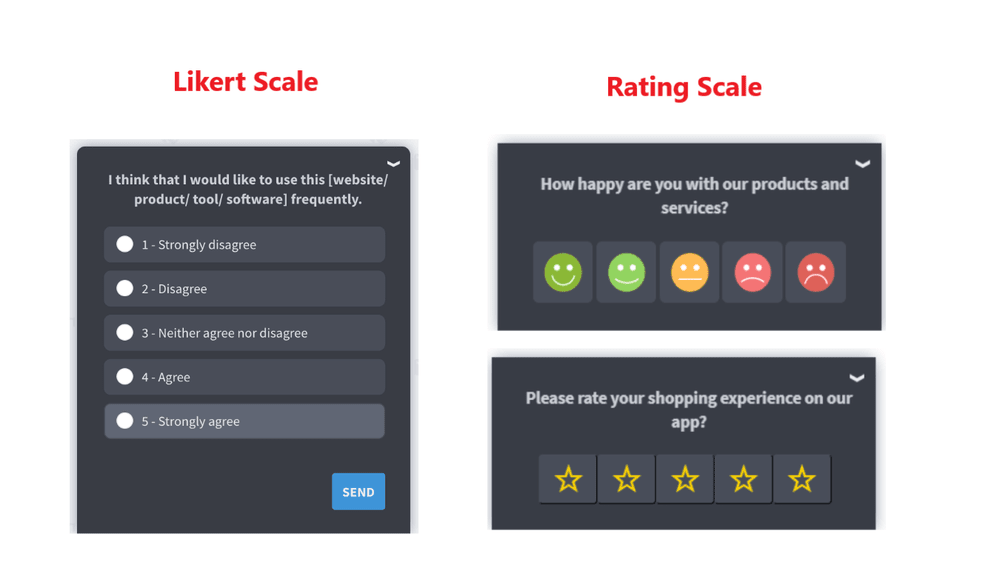
Characteristics of Likert Scale
With the basics laid down, let’s lean closer into the lens and have a microscopic view of what constitutes a Likert scale to use it the right way.
Let’s start with an easy example and navigate the characteristics of this scale through it.
Researchers and surveyors often use this scale with questions that can have dichotomous answers (to collect product feedback in our context).
The questions in the survey (otherwise known as Likert items) are essential statements with options that are suitable answers for the statement showing positive, negative, and neutral responses.
There are many ways to form a question and approach via different words to get the same data.
For example, you can ask customers about their opinion on the product and their experience with it in two different ways where the scales would have different options.
A). You can form the statement (Likert item) like “The product was an amazing purchase” and provide options ranging on the spectrum of highly polarized options like Highly agree, Agree, Somewhat agree, Neither agree nor disagree, Somewhat disagree, Disagree, and Highly disagree.
The degree of responses is based on the type of Likert scale used in the survey, i.e., 5-point, 7-point, etc.
Such scales generally have an odd number of response options for accurate results. Even-numbered options on a 4-point scale may not provide sufficient choices for respondents to answer honestly.
Besides finding the level of disagreement and agreement of the respondents with the Likert items, the scale can measure different things like (which broadly fall under Likert-type scale responses):
- Quality of something with options like Very good, Good, Average, Poor, and Very poor.
- To judge probability with options ranging from Definitely, Probably, Maybe, Probably not, to Definitely not.
- Record frequency of something with options such as Every time, Often, Sometimes, Rarely, Almost never.
- Importance of a product in users’ lives with options like Very important, Important, Fairly important, Slightly Important, and Not at all important.
So, the other way to ask the same question as we were discussing above is:
B). “Please rate your satisfaction level with our product(s).” This state aims to gauge the satisfaction level of customers with the product, so agreement or disagreement options would not make sense as responses.
The ideal responses for such a statement are Very satisfied, Satisfied, Somewhat satisfied, Neutral, Somewhat unsatisfied, Unsatisfied, and Very unsatisfied.
Point to marinate on:
Increasing points on a scale also mean an increase in the reliability of the results. The scales are increased by adding the adjective (or adverb in some cases) ‘Very’ in the response options, as seen in the examples above.
FREE. All Features. FOREVER!
Try our Forever FREE account with all premium features!
Types of Likert Scale You Can Use in Your Surveys
Different types of Likert scale surveys allow researchers and companies to gather different types of data. The variations of this scale we’ll discuss are – Traditional and Likert-type.
1. Traditional Likert Scale
A traditional scale always has a declarative statement. For instance, “The quality of Dominos’ Pizza is top-notch.” is a declarative sentence and doesn’t need any addition from respondents to make sense. The most suitable response options will be from the ‘Agree-disagree’ spectrum.
Notably, the statement is either positive (like our example) or negative but never neutral. Doing this is crucial to elicit definite answers from the customers.
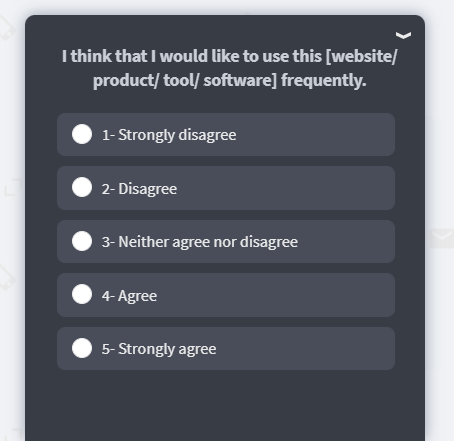
The traditional scale maintains an ordered continuum of response categories to form a meaningful order of options for respondents to pick from quickly. So, it always maintains the “Strongly disagree to Strongly agree” continuum.
Another feature of traditional scales is that it always maintains a balance of positive and negative responses. If you choose this type of scale, make sure to address some kind of numerical value to your response options for effective data analysis.
A 5-point scale is a classic example of a traditional Likert scale type.
2. Likert-type Scale
The Likert-type scale shares a lot of commonalities with the traditional scale. For instance, both follow an ordered continuum of response categories and have an equilibrium of positive and negative options.
What separates both types is that, unlike the traditional scale, the Likert-type scale doesn’t necessarily assign a label or number to each response. It often assigns labels to anchor categories or only to the start and end options.
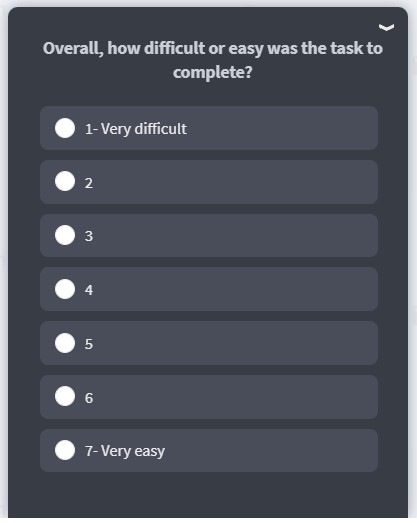
Another big difference is that Likert-type scales don’t follow the traditional type “Agree-disagree” response continuum.
Options discussed in the above sections, such as response continuum to judge probability, record frequency, or even judge the importance of something, all fall under the Likert-type scale category.
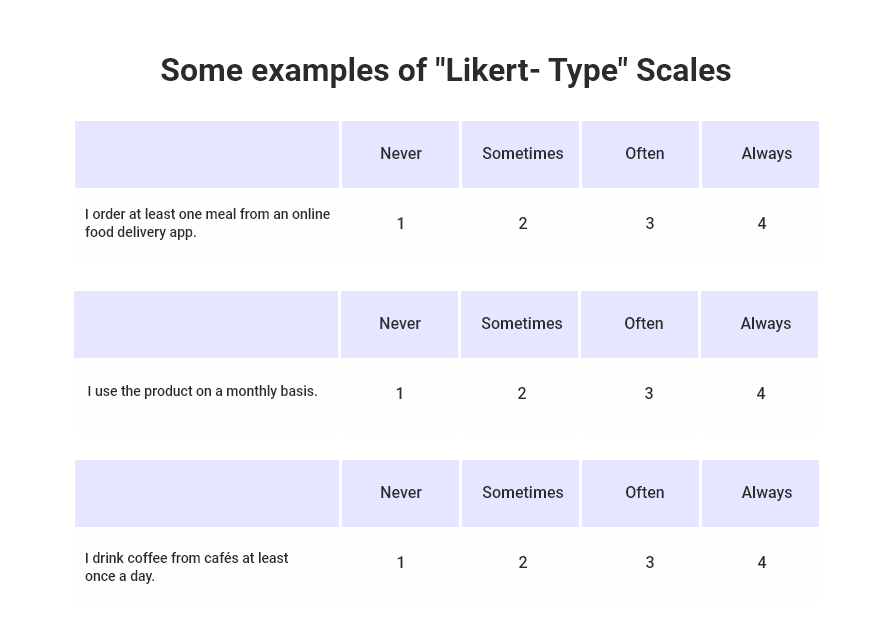
Advantages of Using Likert Scale
Since the Likert scale is one of the popular choices of researchers, it’s only fitting to discuss why it has garnered such attention.
1. Easy for Respondents to Take
Unlike other complex surveys with broad questions, this scale asks respondents in a straightforward language that is easy to understand for giving quick responses.
A complex survey has a low response rate compared to surveys that are readily understandable and easy to take. Customers don’t have to type their responses and just select the option that best suits their opinion.
2. Offers Quantifiable Data
The qualitative data collected through the Likert scale is easy to quantify for effective analysis. It allows companies to pull statistics out of the customer feedback and ensure all the business decisions are fact and statistics-based.
Read Also: Qualitative vs. Quantitative Research: How to Get the Best of Both Worlds
Watch: Use Quantitative Analytics to Define Your Objectives for Feedback
3. Versatile
Likert scale is a universally accepted and used scale because it’s not only easily understood but also can be applied to multiple types of surveys, such as:
- System Usability survey
- Customer Effort Survey
- User Effort Survey
- Employee Satisfaction Survey
- Customer Satisfaction surveys, and many more.
[Additional read: How to Measure Customer Satisfaction With Instant Feedback Surveys]
4. Easy to Compare With Other Samples
Because the scale is widely used across industries, it’s always possible to find sample data similar to yours. It makes the comparison easier, and you can derive incredible insights.
How to Design an Effective Likert Scale Survey
Here are a few tips you need to consider when you create a Likert scale survey to ask your customers the right questions.
Watch: How to build effective surveys
1. Curate Precise and Powerful Statements
In an open-ended survey question like “What did you think of the service in our hotel?”, you can collect diverse feedback on different aspects. For example, you need to assess quality and speed of service, valet service, interaction with employees, quality of accommodation, if the amenities were sufficient, and so much more.
But when it comes to this scale, you can collect precise feedback only when you ask the right questions in the right way.
A similar question in a Likert scale survey like “I liked the service at the hotel” will bring confusing results and make the respondents unclear since they perceive it as a vague statement.
The responses they’ll choose will not reflect which particular aspect of service they are referring to. If they choose ‘Agree,’ you wouldn’t know if they precisely liked the quality of food, interaction with employees, cleanliness of the rooms, etc.
The best way to create an effective survey is to start with a clear statement that focuses on one thing. Here are a few examples:
- “I liked the services offered by the waiting staff.”
- “I found the valet service to be very helpful.”
- “I liked the conduct of the overall staff in the restaurant.”
- “I found the rooms to be very clean and hygienic.” and more.
2. Choose the Appropriate Adjectives
After acing your statement for the survey, you need to ensure you create clear and easily understandable options for the scale. The response continuum should make sense to the respondent to answer honestly.
Using proper adjectives before the intent ‘Agree’ and ‘Disagree’ is pivotal to getting accurate feedback.
So, for a 5-point scale, you should start with adjectives with a high degree such as ‘Highly,’ ‘Extremely,’ ‘Strongly,’ ‘Very,’ etc., for both negative and positive options.
Then, you can use adjectives in the middle to suggest neutrality like ‘Neither/Nor,’ ‘Neutral,’ etc.
It’s the same with a 7-point scale; the only difference is an increase in the number of options that will come right after and before the neutral option. For this, you can use words like ‘Slightly’, ‘Very’, ‘Somewhat,’ and more.
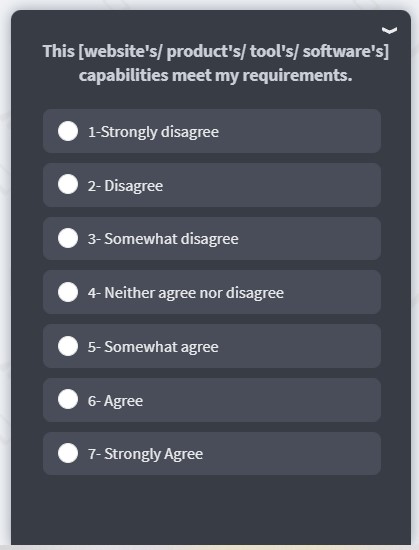
*Note: Very can be used as the word with the highest degree on a 5-point scale and below ‘Highly’ or ‘Extremely’ on a 7-point scale.
3. Make Statements To Identify Different Indicators of Your Research
The Likert scale is often used when you want to understand something that requires more than one question. Because you will be asking multiple questions in your survey, making sure the statements probe at different indicators of your research purpose is crucial.
For example, say you want to research the customer experience of your product. Different characteristics (indicators) make up for a wholesome customer experience, such as the capability of your product, how it meets the expectations of customers, ease of use, and more.
In the image above, each statement has a different indicator to understand the quality of customer experience with the product. So, create statements that consist of and have a balance of positive and negative indicators.
Positive indicator statements have positive words like, “This software is easy to use.”
Negative indicator statements have negative words like, “Using this [Product/Website] is a frustrating experience.”
4. Select Suitable Response Scale and Options
There are two things to discuss here:
A.) Types of response options and
B.) Type of scale to use (Unipolar vs. Bipolar).
So, let’s start with the first option.
The options you choose as responses should match the intent of the statement. If you use a declarative statement like “This product’s capabilities meet my requirements,” then choosing options from the “Agree-disagree” scale is the best choice.
But, if the statement asks a question and asks for the satisfaction level of the customers like, “How would you rate your experience with the website today?” then choosing options from the “Very satisfied-Very unsatisfied” scale would be ideal.
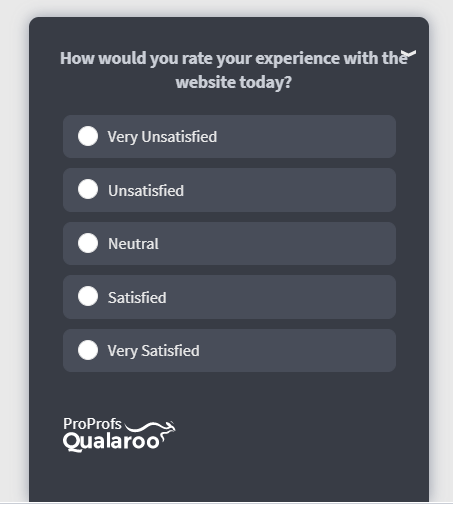
Between unipolar and bipolar, the unipolar scale has options that start from none and go up to the maximum, making sure the start and ends have totally opposite meanings and are methodically correct.
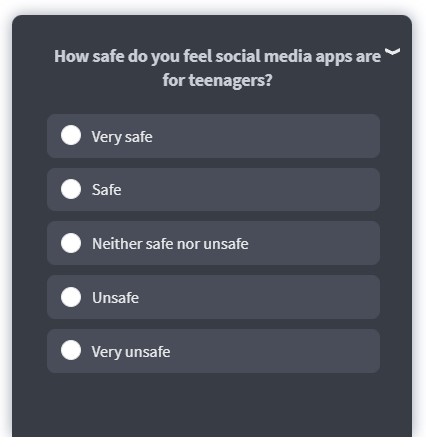
The bipolar scale has options consisting of words opposite of each other. For instance, from the same example above, if we are to add bipolar scale options, then ‘Very unsafe’ would be replaced by the opposite of ‘Very safe,’ which is ‘Dangerous.’
Unipolar is the preferred option since it’s easy to understand and relates the options to the statement and to each other, making the whole Likert survey cohesive.
5. Test and Iterate
Never forget to test your surveys, as it’s an iterative process repeatedly. What may work for you once or with a set of demographics might not be effective with another customer demographics.
Testing your surveys will ensure that the scales you are using are efficient and convey exactly what you are trying to ask, and the responses you are getting are insightful.
Likert Scale: Question Types & Examples
That’s enough theory. Now it’s time to see some action, i.e., Likert scale survey question examples. We’ve divided the section into question types and their examples to make it systematic and easier to understand.
Matrix-Type Likert Scale
This type of scale ensures that you can ask related questions all at once without repeating the questions with slight variations.
Example: “Which of the following is crucial for you while ordering pet supplies online?”
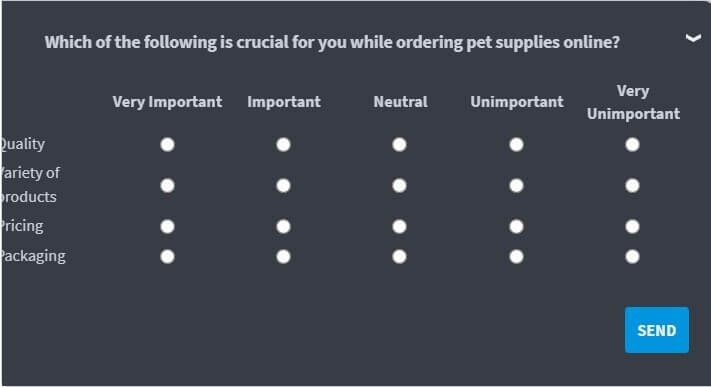
Agreement
It’s to gauge how much customers agree with your statement. It’s one of the most commonly used questions for such a scale as it’s easy to create and understand.
Example 1: “Please choose an appropriate option to show how much you agree or disagree with the following statement: It was easy to navigate the website to find what I was looking for.”
- Strongly disagree
- Somewhat disagree
- Neither agree nor disagree
- Somewhat agree
- Strongly agree
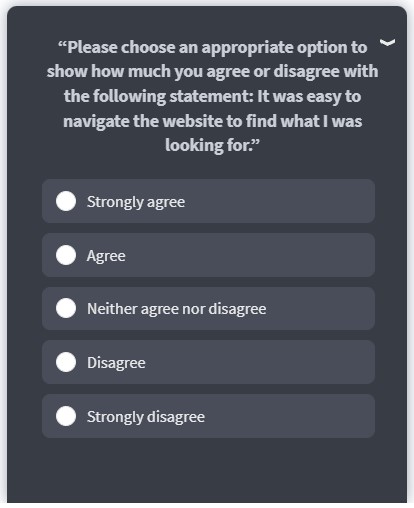
Example 2: “Chocolate ice cream tastes better than vanilla ice cream: On a scale of 1 to 5, how strongly do you agree or disagree with the above statement?”
- Strongly disagree
- Somewhat disagree
- Neither agree nor disagree
- Somewhat agree
- Strongly agree
Likelihood
This question type is used to understand if people will continue to behave the way they currently behave towards a product, service, company, or idea.
Example 1: “How likely are you to recommend this product to your friends and family?”
- Very likely
- Likely
- Neutral
- Unlikely
- Very unlikely
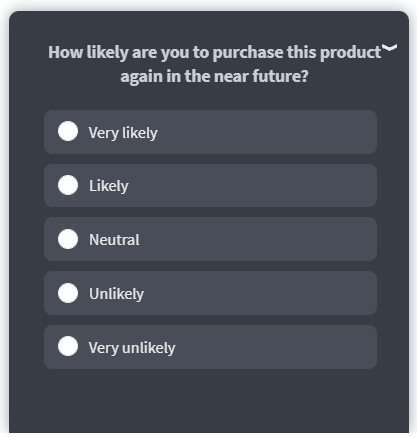
Example 2: “How likely are you to purchase this product again in the near future?”
- Very likely
- Likely
- Neutral
- Unlikely
- Very unlikely
Satisfaction
This type of survey question is asked when you want to collect the subjective opinions of customers. It lets you know how satisfied your customers are with your brand.
Example: “How would you rate your experience with the website today?”
- Very unsatisfied
- Unsatisfied
- Neutral
- Satisfied
- Very satisfied
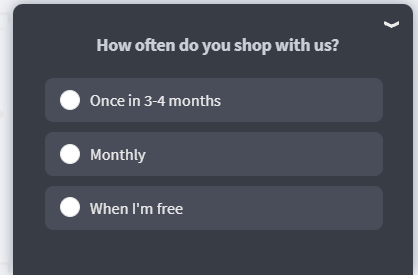
Related Read: Best Website Survey Questions to ask your users
Importance
The importance Likert scale is good to use when you want to know how customers feel about certain things and how much they matter to them.
Example 1: “How important is the [product feature] to you?”
- Very important
- Important
- Low importance
- Not important at all
Example 2: “How important is the ‘Save for later’ function for you on a website?”
- Very important
- Important
- Not important at all

Frequency
Frequency Likert scale questions aim to gauge the frequency at which customers do something, which gives an idea about their behavior.
Example 1: “In the last week, how often did you read something (e.g., news, articles, etc.) from your phone vs. a newspaper?
- Much less on the phone than in a newspaper
- Moderately less on the phone than in a newspaper
- Same for both
- Moderately more on the phone than in a newspaper
- Much more on the phone than in a newspaper

Example 2: How often do you seek assistance from customer support?
- Very frequently
- Occasionally
- Rarely
- Never
Example 3: How often did you use public transportation during a regular week before COVID-19?
- 1 to 2 days a week
- 3 to 4 days a week
- 5 days a week
- 6 to 7 days a week
- Never
Example 4: “How often do you shop with us?”
- Once in 3-4 month
- Monthly
- When I’m free
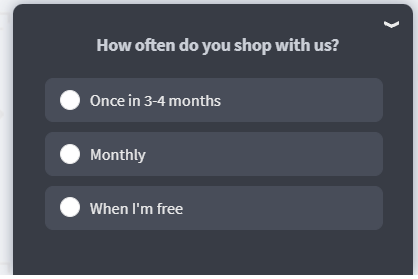
Quality
These questions are directed towards understanding customers’ views about the company’s quality of services and products.
Example 1: “How would you rate the quality of the product?”
- Very Poor
- Below Average
- Average
- Above Average
- Excellent
Example 2: “From the following options, how would you rate the food at our in-hotel restaurant?”
- Very tasty
- Tasty
- Ok-ok
- Not at all tasty

Dichotomous
Dichotomous Likert survey questions have two options that are the fundamentally extreme opposite of each other: True-False and Yes-No.
Example: “Are filters on this [Website/tool/software] helpful?”
- Yes
- No

FREE. All Features. FOREVER!
Try our Forever FREE account with all premium features!
Best Practices to Remember for Likert Scale Surveys
Now that we are through several examples of Likert survey questions and how to form them, it won’t hurt to go through best practices to ensure you only launch effective surveys.
1. Choose Words Over Numbers When You Can
Creating a Likert scale survey with only numbers as options might confuse respondents regarding which number is positive or negative. That’s why words do a better job at conveying your intent so that customers can respond accordingly.
2. Odd Likert Scale Is Effective
Since the odd scale has a neutral point, it becomes easier for people to choose the options without feeling overwhelmed or that there’s a lack of diverse options.
So, you can use a 5-point scale for your unipolar scale and a 7-point scale for your bipolar scale if you want to provide diverse response options to customers without overwhelming them.
3. Maintain Consistency Throughout Options

Keep the formatting of your scale survey in mind as it’s pivotal for respondents’ true interpretation of the survey options.
Making the survey aesthetically pleasing is as crucial as making it intellectually appealing to get the right customer feedback. So, never miss to hit the spacebar and keep your backspace button in check!
Related Read: Product Feedback Survey Questions & Examples
4. Make Surveys Wholesome
There are as many opinions as there are people. Although it’s hard to capture the entirety of the unique perspective of each respondent using surveys, we can still get a good glimpse of their experiences and views.
While creating surveys, the importance of integrating different opinions can’t be stressed enough. Include positive, negative, and neutral options to make it wholesome. It ensures you collect different opinions condensed into those options.
For example, if you ask “How was the quality of cleaning in room service?” and only give options like “Excellent,” “Very good,” “Good,” and “Somewhat good,” you will lose the authentic feedback of respondents who wanted to opt for a different option like “Very poor.”
They will be forced to give feedback they do not mean, defeating the whole point of collecting feedback.
5. Practice Skip Logic
In any kind of survey, it’s important to allow people to skip over questions they do not want or feel comfortable answering. It enhances their experience while taking the survey. Doing this will also ensure respondents do not feel frustrated and answer the following questions out of frustration.
Here’s how to use branching or skip logic within a survey
The Right Time to Use the Likert Scale Questionnaire
In essence, Likert scale surveys are helpful when you want to gauge people’s opinions about something.
In the business world, among a long list of different surveys like Net Promoter Score, Customer Effort Score, and more, this scale has its special place and purpose to fulfill.
So, it’s always best to choose a Likert scale survey over others when you want to:
- Expand your product line and perform market research for the planned product.
- Plan a new feature addition, so you want to understand what customers think of it and what additional functions you can add.
- Conduct an Employee Satisfaction survey within the organization.
- Understand how people react to your new product.
- Gauge customer satisfaction and experience with your company and support services.
Must Read: Best Online Market Research Software & Tools
The Right Place To Deploy Likert Scale Surveys
So we know the right time to use the Likert surveys, but what about the ‘Where’ part? Well, that’s what we’ll find out now.
With tools such as Qualaroo, you can easily embed Likert scale surveys:
- On entire websites or a few selected pages (with personalized URLs) using the NudgeTM. With this feature you can embed your pop-up surveys anywhere on the website and collect feedback in a non-intrusive way.
- On mobile apps using survey templates or creating surveys from scratch.
- Embed surveys on live chat support windows using software like ProProfs Live Chat and collect feedback directly.
- On prototypes to gather feedback before you launch a finished product.
Related Read: 10 Best Exit Intent Popup Tools
Likert Scale Surveys Challenges & How to Overcome Them
To tie a neat bow on this article, let’s wrap it up by discussing the challenges you may face with your survey and what steps you can take to avoid them, or at least minimize the damage.
These challenges come in the form of biases. Here are the three biases and their solutions:
1. Acquiescence Response Bias: Under this bias, people tend to agree with the statements given in the Likert survey just to please others. Another name it goes by is “when-in-doubt-just-agree bias. ”
The best way to avoid this is by changing statements into question form or adding both positive and negative statements to the Likert scale to balance it out.
2. Social Desirability Bias: As the name suggests, this bias occurs when respondents give socially acceptable answers instead of sharing their genuine opinions. The best way to avoid this crisis is by disclaiming that the feedback is anonymous, so their answers will not be shared publicly.
3.Tendency Bias: People tend to avoid choosing the most extreme options. The best way to go around this problem is by explaining what each extreme option means.
For example, if you are asking customers about the quality of the room service, you can explain that “Excellent” means you are happy with the work of the room service agent and their attitude.
4.Extreme Response Bias: Contrary to tendency bias, extreme response bias happens when respondents only choose extreme options. There are many factors at play deciding why respondents behave this way, including IQ and cultural attitudes. You can effectively avoid this situation by wording statements in a neutral tone and not using leading statements.
Get Insightful Feedback With Likert Surveys
With filtered data from your surveys, you can improve customer experience by acting on the feedback.
This simple yet valuable feedback can give answers such as what customers find useful in your product, whether they are satisfied with the overall experience or not, and more.
You just need to understand your needs, customer behavior, and market to decide which Likert scale is best for the job, i.e., 5-point, 4-point, and a 7-point scale. The most common is the 5-point scale since it has a neutral middle option and offers enough choices for customers to choose their desired answer.
You can use branching logic and ask open-ended follow-up questions to collect the context behind the responses and turn insights into “actionable feedback.” So, buckle up to create impressive surveys, listen to the voice of your customers, and start taking action.
FAQs
How to analyze a Likert scale survey?
Using tools like Qualaroo, you can quickly analyze feedback data from Likert scale surveys, thanks to advanced and Sentiment Analysis.
Why should you use the Likert scale?
Likert scale survey allows you to ask customers feedback in a very engaging and easy way. They are flexible as they allow you to choose from multiple scale types such as 4-point, 5-point, and 7-point scale surveys.
How to organize data from the Likert scale survey?
Likert scale surveys gather qualitative and quantitative data that is easy to organize with tools like Qualaroo that allow you to create Likert surveys and launch on different platforms and collect the data in an organized way for deep analysis.
Should I use the middle position on the Likert scale?
Yes, the middle point in a 5-point and 7-point scale survey allows a neutral point for customers to choose if they do not want to give either positive or negative feedback.
 Tips
Tips
We’d love to hear your tips & suggestions on this article!
FREE. All Features. FOREVER!
Try our Forever FREE account with all premium features!

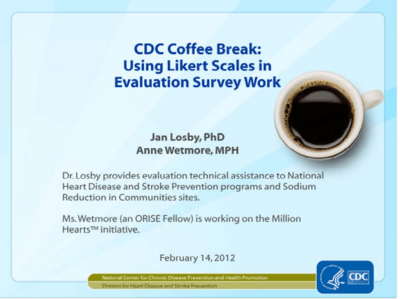
 We'd love your feedback!
We'd love your feedback! Thanks for your feedback!
Thanks for your feedback!




